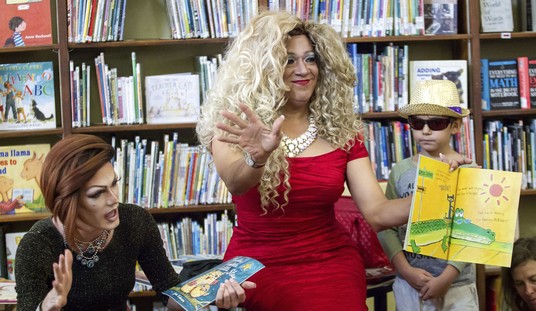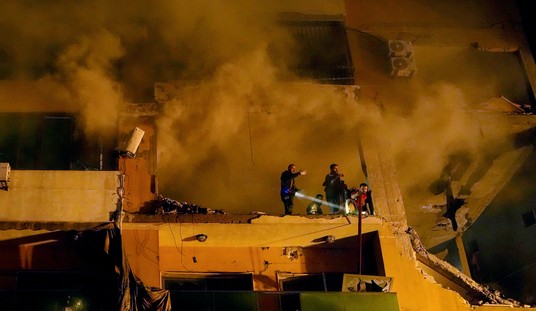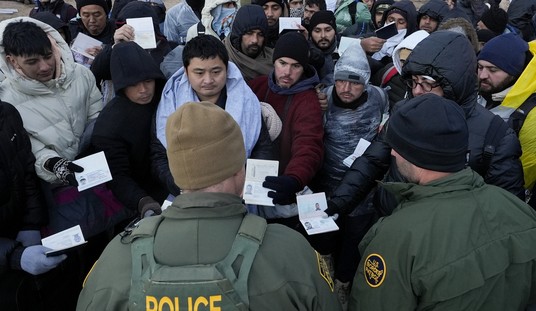If Dr. Maria Van Kerkhove suspected MERS-like transmission of the emerging COVID-19 outbreak in China, then why did the World Health Organization explicitly cast doubt on the risk of human-to-human transmission two weeks later? In a WHO briefing yesterday, a reporter asked WHO’s representatives to answer criticism from the White House that WHO was “late to the game” on the coronavirus’ pandemic potential. Van Kerkhove carefully explains that she knew full well that a respiratory illness like COVID-19 could spread through droplets and human contact, and explicitly advised WHO of that danger.
And yet … watch from the 22-minute mark to see the contradiction in this defense (via Leah Barkoukis at Townhall):
Q: I go back to the criticisms from the White House last week, especially in regards to the early actions by WHO. President Trump and others, by the way, said that WHO was late to the game, so to speak, especially on the declaration of human to human transmission. I’m wondering if you could address that criticism and, very quickly, if you could also — what would be the financial gut-punch, if you will, if funding from the biggest donor [in the] world were withdrawn. I think the world needs to know how badly this would affect the organization at this crucial time. Thank you very much.
A: So thank you for that question. I will start and perhaps Dr. Tedros and Mike want to supplement with this. So with regards to the human-to-human transmission question, so right from the start, from the first notification that we received on the 31st of December, given that this was a cluster of pneumonia. I’m a MERS specialist, so my background is in coronaviruses and in influenza, so [I] immediately thought, given that it’s a respiratory pathogen, that of course there may be human to human transmission.
So initially when we started to put together our technical guidance for our member states, we put guidance that focused on how this virus could be transmitted. And what we focused on was droplet and contact transmission, which is how respiratory pathogens are spread. We also within our infection prevention and control guidance put out a special provision for healthcare workers who are focused on conducting aerosol generating procedures, in which we put in place recommendations for airborne transmission. That guidance is still in effect. The guidance that we put up was on the 10th of January. It was the 10th and the 11th of January because there were five or six technical guidance materials that were actually put up on the web, which were open to everyone.
That timing becomes verrrrry interesting, because it was just three days later that WHO officially advised the world that they had no evidence at all of a risk of community spread. They announced this based on China’s data rather than Kerkhove’s own work and analysis, for some reason:
Preliminary investigations conducted by the Chinese authorities have found no clear evidence of human-to-human transmission of the novel #coronavirus (2019-nCoV) identified in #Wuhan, #China🇨🇳. pic.twitter.com/Fnl5P877VG
— World Health Organization (WHO) (@WHO) January 14, 2020
That becomes even more inexplicable when reading Taiwan’s brief to WHO on December 31, the same time Van Kerkhove began studying the issue. They warned that their cases looked like an “atypical pneumonia,” and that they had placed them in isolation. From that, WHO should have inferred some reason to suspect risk of human-to-human transmission, or at least asked about it, a statement from Taiwan Centers for Disease Control argued:
Owing to its experience with the SARS epidemic in 2003, Taiwan vigilantly kept track of information about the new outbreak. On December 31, 2019, Taiwan sent an email to the International Health Regulations (IHR) focal point under the World Health Organization (WHO), informing WHO of its understanding of the disease and also requesting further information from WHO. Given the lack of clarity at the time, as well as the many rumors that were circulating, Taiwan’s aim was to ensure that all relevant parties remained alert, especially since the outbreak occurred just before the Lunar New Year holiday, which typically sees tremendous amounts of travel. To be prudent, in the email we took pains to refer to atypical pneumonia, and specifically noted that patients had been isolated for treatment. Public health professionals could discern from this wording that there was a real possibility of human-to-human transmission of the disease. However, because at the time there were as yet no cases of the disease in Taiwan, we could not state directly and conclusively that there had been human-to-human transmission.
The Taiwan CDC also contacted the Chinese Center for Disease Control and Prevention in a bid to obtain more information. However, in response to our inquiries, the WHO IHR focal point only responded with a short message stating that Taiwan’s information had been forwarded to expert colleagues; China provided only a press release.
Even though Taiwan strongly suspected that human-to-human transmission of the disease was already occurring at the time, we were unable to gain confirmation through existing channels. Therefore, on the day the aforementioned email was sent to WHO, the Taiwan government activated enhanced border control and quarantine measures based on the assumption that human-to-human transmission was in fact occurring. These measures included screening passengers on flights from Wuhan prior to disembarkation.
In mid-January, the Taiwan CDC dispatched experts to Wuhan to gain a better understanding of the epidemic, the control measures taken there, and patients’ exposure history. Based on preliminary research, Taiwan determined that this form of pneumonia could indeed spread via human-to-human transmission.
Mid-January was the same time that WHO announced they had no evidence of human-to-human transmission. It would take until the end of the month before WHO finally admitted that it was a huge risk, far too late to contain the pandemic in place. Rather than focus on the real danger to world health, Tedros and WHO participated in a political cover-up for Beijing, including the marginalizing of Taiwan rather than pay attention to their input.
It’s not the first time that Tedros has been accused of putting politics above health, either. Katie Pavlich reminds us that Tedros got accused of three such cover-ups before his confirmation to run WHO:
In an interview, Dr. Tedros, who was Ethiopia’s health minister from 2005 to 2012 and remains highly regarded for his accomplishments then, denied covering up cholera.
Outbreaks occurring in 2006, 2009 and 2011, he said, were only “acute watery diarrhea” in remote areas where laboratory testing “is difficult.” That is what the Ethiopian government said then and is saying now about an outbreak that began in January.
W.H.O. officials have complained privately that Ethiopian officials are not telling the truth about these outbreaks. Testing for Vibrio cholerae bacteria, which cause cholera, is simple and takes less than two days.
During earlier outbreaks, various news organizations, including The Guardian and The Washington Post, reported that unnamed Ethiopian officials were pressuring aid agencies to avoid using the word “cholera” and not to report the number of people affected.
But cholera bacteria were found in stool samples tested by outside experts. As soon as severe diarrhea began appearing in neighboring countries, the cause was identified as cholera.
United Nations officials said more aid could have been delivered to Ethiopia had the truth been told.
One has to suspect that China, which served at Tedros’ patron in his confirmation, saw this as a resumé enhancer rather than a non-starter. Their investment paid off remarkably well, too, as WHO managed to delay a global response until China could put its propaganda machine into high gear. This is an utterly shameful performance, and the utterly corrupt leadership that produced it should be immediately removed — and defunded until it is replaced.
Update: Axios reports this morning that seven Senate Republicans have sent a demand for answers from Tedros and WHO, and made it clear that their response will matter when it comes to funding decisions. They apparently suspect that some WHO officials might be on the take:
The lawmakers made several requests for information, including:
- When a WHO team first arrived in China to begin investigating the outbreak
- Who was in charge of coordinating the WHO’s investigation with the Chinese Communist Party
- Any financial compensation the organization’s leaders receive beyond their WHO salaries
- Disclosure of documents and communications in late 2019 and early 2020 relating to the coronavirus response in China, especially those between the WHO and China’s leadership
It’s probably not out of the question, but this might be more of a case of corrupt patronage than outright bribery. At this point, though, there’s no sense in foreclosing any possibility before an investigation starts.







Join the conversation as a VIP Member